Assessment and Mapping of Riverine Flood Susceptibility (RFS) in India through Coupled Multicriteria Decision Making Models and Geospatial Techniques
Abstract
:1. Introduction
2. Materials and Methods
2.1. Study Area
2.2. Database and Methodology
2.2.1. Hydrological Factors
2.2.2. Geomorphological Factors
2.2.3. Meteorological Factor
2.2.4. Anthropogenic Factor
2.3. Validation Points
2.4. Fuzzy Analytical Hierarchy Process (FAHP)
2.5. Flood Susceptibility Mapping
2.6. Validation Using AUROC Analysis
3. Results
3.1. Influence of Factors on Riverine Floods
3.2. Flood Susceptibility Zonation
3.3. Flood Susceptibility Validation Using AUROC Analysis
3.4. Riverine Flood Susceptibility (RFS) Assessment of Indian River Basins
3.5. RFS Assessment of Indian Cities
3.6. Land Cover Susceptibility Assessment of India
4. Discussion
5. Conclusions
Supplementary Materials
Author Contributions
Funding
Data Availability Statement
Acknowledgments
Conflicts of Interest
References
- Lee, S.; Kim, J.-C.; Jung, H.-S.; Lee, M.J.; Lee, S. Spatial prediction of flood susceptibility using random-forest and boosted-tree models in Seoul metropolitan city, Korea. Geomat. Nat. Hazards Risk 2017, 8, 1185–1203. [Google Scholar] [CrossRef]
- Ahmadlou, M.; Al-Fugara, A.; Al-Shabeeb, A.R.; Arora, A.; Al-Adamat, R.; Pham, Q.B.; Al-Ansari, N.; Linh, N.T.T.; Sajedi, H. Flood susceptibility mapping and assessment using a novel deep learning model combining multilayer perceptron and autoencoder neural networks. J. Flood Risk Manag. 2020, 14, e12683. [Google Scholar] [CrossRef]
- Diaz, J.H. Global Climate Changes, Natural Disasters, and Travel Health Risks. J. Travel Med. 2006, 13, 361–372. [Google Scholar] [CrossRef]
- Zêzere, J.L.; Pereira, S.; Tavares, A.O.; Bateira, C.; Trigo, R.M.; Quaresma, I.; Santos, P.P.; Santos, M.; Verde, J. DISASTER: A GIS database on hydro-geomorphologic disasters in Portugal. Nat. Hazards 2014, 72, 503–532. [Google Scholar] [CrossRef]
- He, B.; Huang, X.; Ma, M.; Chang, Q.; Tu, Y.; Li, Q.; Zhang, K.; Hong, Y. Analysis of flash flood disaster characteristics in China from 2011 to 2015. Nat. Hazards 2017, 90, 407–420. [Google Scholar] [CrossRef]
- Kundzewicz, Z.W.; Su, B.; Wang, Y.; Wang, G.; Wang, G.; Huang, J.; Jiang, T. Flood risk in a range of spatial perspectives—From global to local scales. Nat. Hazards Earth Syst. Sci. 2019, 19, 1319–1328. [Google Scholar] [CrossRef]
- Merz, B.; Blöschl, G.; Vorogushyn, S.; Dottori, F.; Aerts, J.C.J.H.; Bates, P.; Bertola, M.; Kemter, M.; Kreibich, H.; Lall, U.; et al. Causes, impacts and patterns of disastrous river floods. Nat. Rev. Earth Environ. 2021, 2, 592–609. [Google Scholar] [CrossRef]
- Purohit, J.; Rout, H.S. Impact of climate change on human health concerning climate-induced natural disaster: Evidence from an eastern Indian state. Clim. Chang. 2023, 176, 1–22. [Google Scholar] [CrossRef]
- Sanchez, M.C.J. World Disasters Report 2020: Chapter 4 Reducing Risks and Building Resilience–Minimizing the Impacts of Potential and Predicted Extreme Events. International Federation of Red Cross and Red Crescent Societies. 2020. Available online: https://research.utwente.nl/en/publications/world-disasters-report-2020-chapter-4-reducing-risks-and-building (accessed on 27 September 2023).
- Haynes, K.; Coates, L.; Honert, R.v.D.; Gissing, A.; Bird, D.; de Oliveira, F.D.; Darcy, R.; Smith, C.; Radford, D. Exploring the circumstances surrounding flood fatalities in Australia—1900–2015 and the implications for policy and practice. Environ. Sci. Policy 2017, 76, 165–176. [Google Scholar] [CrossRef]
- Jamali, B.; Bach, P.M.; Deletic, A. Rainwater harvesting for urban flood management–An integrated modelling framework. Water Res. 2019, 171, 115372. [Google Scholar] [CrossRef] [PubMed]
- Raj, R.; Yunus, A.P.; Pani, P.; Avtar, R. Towards evaluating gully erosion volume and erosion rates in the Chambal badlands, Central India. Land Degrad. Dev. 2022, 33, 1495–1510. [Google Scholar] [CrossRef]
- Saini, A.; Sahu, N.; Kumar, P.; Nayak, S.; Duan, W.; Avtar, R.; Behera, S. Advanced Rainfall Trend Analysis of 117 Years over West Coast Plain and Hill Agro-Climatic Region of India. Atmosphere 2020, 11, 1225. [Google Scholar] [CrossRef]
- Doswell, C.A.; Brooks, H.E.; Maddox, R.A. Flash Flood Forecasting: An Ingredients-Based Methodology. Weather Forecast. 1996, 11, 560–581. [Google Scholar] [CrossRef]
- Sahu, N.; Panda, A.; Nayak, S.; Saini, A.; Mishra, M.; Sayama, T.; Sahu, L.; Duan, W.; Avtar, R.; Behera, S. Impact of Indo-Pacific Climate Variability on High Streamflow Events in Mahanadi River Basin, India. Water 2020, 12, 1952. [Google Scholar] [CrossRef]
- Mohanty, M.P.; Mudgil, S.; Karmakar, S. Flood management in India: A focussed review on the current status and future challenges. Int. J. Disaster Risk Reduct. 2020, 49, 101660. [Google Scholar] [CrossRef]
- Manivannan, S.; Thilagam, V.K.; Khola, O. Soil and water conservation in India: Strategies and research challenges. J. Soil Water Conserv. 2017, 16, 312. [Google Scholar] [CrossRef]
- Bhawan, S.; Puram, R. Watershed Atlas of India. New Delhi Center Water Commision, 2014. Available online: https://www.researchgate.net/publication/316663108_WATERSHED_ATLAS_OF_INDIA (accessed on 24 September 2023).
- Sutradhar, S.; Mondal, P. Prioritization of watersheds based on morphometric assessment in relation to flood management: A case study of Ajay river basin, Eastern India. Watershed Ecol. Environ. 2023, 5, 1–11. [Google Scholar] [CrossRef]
- Panda, P.K. Vulnerability of flood in India: A remote sensing and GIS approach for warning, mitigation and management. Asian J. Sci. Technol. 2014, 5, 843–846. [Google Scholar]
- Green, C. Flood Risk Management in Europe: The Flood Problem and Interventions; Revision 4; STAR-FLOOD Consortium: Utrecht, The Netherlands, 2013. [Google Scholar]
- Conitz, F.; Zingraff-Hamed, A.; Lupp, G.; Pauleit, S. Non-Structural Flood Management in European Rural Mountain Areas—Are Scientists Supporting Implementation? Hydrology 2021, 8, 167. [Google Scholar] [CrossRef]
- Kron, W.; Steuer, M.; Löw, P.; Wirtz, A. How to deal properly with a natural catastrophe database—Analysis of flood losses. Nat. Hazards Earth Syst. Sci. 2012, 12, 535–550. [Google Scholar] [CrossRef]
- Nied, M.; Schröter, K.; Lüdtke, S.; Nguyen, V.D.; Merz, B. What are the hydro-meteorological controls on flood characteristics? J. Hydrol. 2017, 545, 310–326. [Google Scholar] [CrossRef]
- Youssef, A.M.; Pradhan, B.; Sefry, S.A. Flash flood susceptibility assessment in Jeddah city (Kingdom of Saudi Arabia) using bivariate and multivariate statistical models. Environ. Earth Sci. 2015, 75, 1–16. [Google Scholar] [CrossRef]
- Jothibasu, A.; Anbazhagan, S. Flood susceptibility appraisal in Ponnaiyar River Basin, India using frequency ratio (FR) and Shannon’s Entropy (SE) models. Int. J. Adv. Rem. Sens. GIS 2016, 5, 1946–1962. [Google Scholar]
- Rehman, S.; Hasan, M.S.U.; Rai, A.K.; Rahaman, M.H.; Avtar, R.; Sajjad, H. Integrated approach for spatial flood susceptibility assessment in Bhagirathi sub-basin, India using entropy information theory and geospatial technology. Risk Anal. 2022, 42, 2765–2780. [Google Scholar]
- Rahmati, O.; Pourghasemi, H.R.; Zeinivand, H. Flood susceptibility mapping using frequency ratio and weights-of-evidence models in the Golastan Province, Iran. Geocarto Int. 2015, 31, 42–70. [Google Scholar] [CrossRef]
- Zhao, G.; Pang, B.; Xu, Z.; Peng, D.; Xu, L. Assessment of urban flood susceptibility using semi-supervised machine learning model. Sci. Total Environ. 2018, 659, 940–949. [Google Scholar] [CrossRef]
- Chen, J.; Zhang, Y.; Chen, Z.; Nie, Z. Improving assessment of groundwater sustainability with analytic hierarchy process and information entropy method: A case study of the Hohhot Plain, China. Environ. Earth Sci. 2014, 73, 2353–2363. [Google Scholar] [CrossRef]
- Li, J. A data-driven improved fuzzy logic control optimization-simulation tool for reducing flooding volume at downstream urban drainage systems. Sci. Total Environ. 2020, 732, 138931. [Google Scholar] [CrossRef]
- Tien Bui, D.; Khosravi, K.; Shahabi, H.; Daggupati, P.; Adamowski, J.F.; Melesse, A.M.; Pham, B.T.; Pourghasemi, H.R.; Bahrami, S. Flood Spatial Modeling in Northern Iran Using Remote Sensing and GIS: A Comparison between Evidential Belief Functions and Its Ensemble with a Multivariate Logistic Regression Model. Remote Sens. 2019, 11, 1589. [Google Scholar] [CrossRef]
- Tiwari, M.K.; Chatterjee, C. Development of an accurate and reliable hourly flood forecasting model using wavelet–bootstrap–ANN (WBANN) hybrid approach. J. Hydrol. 2010, 394, 458–470. [Google Scholar] [CrossRef]
- Kia, M.B.; Pirasteh, S.; Pradhan, B.; Mahmud, A.R.; Sulaiman, W.N.A.; Moradi, A. An artificial neural network model for flood simulation using GIS: Johor River Basin, Malaysia. Environ. Earth Sci. 2011, 67, 251–264. [Google Scholar] [CrossRef]
- Elsafi, S.H. Artificial Neural Networks (ANNs) for flood forecasting at Dongola Station in the River Nile, Sudan. Alex. Eng. J. 2014, 53, 655–662. [Google Scholar] [CrossRef]
- Kourgialas, N.N.; Anyfanti, I.; Karatzas, G.P.; Dokou, Z. An integrated method for assessing drought prone areas–Water efficiency practices for a climate resilient Mediterranean agriculture. Sci. Total Environ. 2018, 625, 1290–1300. [Google Scholar] [CrossRef] [PubMed]
- Khosravi, K.; Pham, B.T.; Chapi, K.; Shirzadi, A.; Shahabi, H.; Revhaug, I.; Prakash, I.; Bui, D.T. A comparative assessment of decision trees algorithms for flash flood susceptibility modeling at Haraz watershed, northern Iran. Sci. Total Environ. 2018, 627, 744–755. [Google Scholar] [CrossRef]
- Tehrany, M.S.; Pradhan, B.; Mansor, S.; Ahmad, N. Flood susceptibility assessment using GIS-based support vector machine model with different kernel types. CATENA 2015, 125, 91–101. [Google Scholar] [CrossRef]
- Choubin, B.; Moradi, E.; Golshan, M.; Adamowski, J.; Sajedi-Hosseini, F.; Mosavi, A. An ensemble prediction of flood susceptibility using multivariate discriminant analysis, classification and regression trees, and support vector machines. Sci. Total Environ. 2018, 651, 2087–2096. [Google Scholar] [CrossRef]
- Termeh, S.V.R.; Kornejady, A.; Pourghasemi, H.R.; Keesstra, S. Flood susceptibility mapping using novel ensembles of adaptive neuro fuzzy inference system and metaheuristic algorithms. Sci. Total Environ. 2018, 615, 438–451. [Google Scholar] [CrossRef]
- Amodei, D.; Olah, C.; Steinhardt, J.; Christiano, P.; Schulman, J.; Mané, D. Concrete Problems in AI Safety. arXiv 2016, arXiv:1606.06565. [Google Scholar] [CrossRef]
- Poursabzi-Sangdeh, F.; Goldstein, D.G.; Hofman, J.M.; Vaughan, J.W.W.; Wallach, H. Manipulating and Measuring Model Interpretability. In Proceedings of the CHI’21: CHI Conference on Human Factors in Computing Systems, Yokohama, Japan, 8–13 May 2021. [Google Scholar]
- Murdoch, W.J.; Singh, C.; Kumbier, K.; Abbasi-Asl, R.; Yu, B. Definitions, methods, and applications in interpretable machine learning. Proc. Natl. Acad. Sci. USA 2019, 116, 22071–22080. [Google Scholar] [CrossRef]
- Saaty, T.L.; Tran, L.T. On the invalidity of fuzzifying numerical judgments in the Analytic Hierarchy Process. Math. Comput. Model. 2007, 46, 962–975. [Google Scholar] [CrossRef]
- Saaty, T.L. The Analytic Hierarchy Process; McGraw-Hill: New York, NY, USA, 1980. [Google Scholar]
- Kahraman, C.; Ruan, D.; Doǧan, I. Fuzzy group decision-making for facility location selection. Inf. Sci. 2003, 157, 135–153. [Google Scholar] [CrossRef]
- Das, B.; Pal, S.C. Combination of GIS and fuzzy-AHP for delineating groundwater recharge potential zones in the critical Goghat-II block of West Bengal, India. HydroResearch 2019, 2, 21–30. [Google Scholar] [CrossRef]
- van Laarhoven, P.; Pedrycz, W. A fuzzy extension of Saaty’s priority theory. Fuzzy Sets Syst. 1983, 11, 229–241. [Google Scholar] [CrossRef]
- Kubler, S.; Robert, J.; Derigent, W.; Voisin, A.; Le Traon, Y. A state-of the-art survey & testbed of fuzzy AHP (FAHP) applications. Expert Syst. Appl. 2016, 65, 398–422. [Google Scholar] [CrossRef]
- Panda, D.K.; Tiwari, V.M.; Rodell, M. Groundwater Variability Across India, Under Contrasting Human and Natural Conditions. Earth’s Future 2022, 10, 2513. [Google Scholar] [CrossRef]
- United Nations Department of Economic and Social Affairs. Population Division, World Population Prospects 2022: Summary of Results. UN DESA/POP/2022/TR/NO. 3. 2022. Available online: https://desapublications.un.org/file/989/download (accessed on 24 September 2023).
- Vegad, U.; Pokhrel, Y.; Mishra, V.; Ghosh, A.; Kar, S.K. Application of analytical hierarchy process (AHP) for flood risk assessment: A case study in Malda district of West Bengal, India. Hydrol. Earth Syst. Sci. Discuss. 2018, 94, 349–368. [Google Scholar]
- Ganio, L.M.; Torgersen, C.E.; Gresswell, R.E. A geostatistical approach for describing spatial pattern in stream networks. Front. Ecol. Environ. 2005, 3, 138–144. [Google Scholar] [CrossRef]
- Horton, R.E. Erosional development of streams and their drainage basins; hydrophysical approach to quantitative morphology. Geol. Soc. Am. Bull. 1945, 56, 275–370. [Google Scholar] [CrossRef]
- Wolock, D.M.; McCabe, G.J., Jr. Comparison of single and multiple flow direction algorithms for computing topo-graphic parameters in TOPMODEL. Water Resour. Res. 1995, 31, 1315–1324. [Google Scholar] [CrossRef]
- Yin, J.; Guo, S.; Liu, Z.; Yang, G.; Zhong, Y.; Liu, D. Uncertainty analysis of bivariate design flood estimation and its im-pacts on reservoir routing. Water Resour. Manag. 2018, 32, 1795–1809. [Google Scholar] [CrossRef]
- Jenks, G.F. Optimal Data Classification for Choropleth Maps. Dep. Geogr. Univ. Kans. Occas. Pap. 1977. Available online: https://cir.nii.ac.jp/crid/1570572700325134464 (accessed on 5 October 2023).
- Campbell, J.B.; Wynne, R.H. Introduction to Remote Sensing; Guilford Press: New York, NY, USA, 2011. [Google Scholar]
- Tehrany, M.S.; Kumar, L. The application of a Dempster–Shafer-based evidential belief function in flood susceptibility mapping and comparison with frequency ratio and logistic regression methods. Environ. Earth Sci. 2018, 77, 490. [Google Scholar] [CrossRef]
- Kaliraj, S.; Chandrasekar, N.; Magesh, N. Morphometric analysis of the River Thamirabarani sub-basin in Kanya-kumari District, South west coast of Tamil Nadu, India, using remote sensing and GIS. Environ. Earth Sci. 2015, 73, 7375–7401. [Google Scholar] [CrossRef]
- Mousavi, S.M.; Ataie-Ashtiani, B.; Hosseini, S.M. Comparison of statistical and mcdm approaches for flood susceptibility mapping in northern Iran. J. Hydrol. 2022, 612, 128072. [Google Scholar] [CrossRef]
- Ohlmacher, G.C. Plan curvature and landslide probability in regions dominated by earth flows and earth slides. Eng. Geol. 2007, 91, 117–134. [Google Scholar] [CrossRef]
- Mahmoud, S.H.; Gan, T.Y. Urbanization and climate change implications in flood risk management: Developing an efficient decision support system for flood susceptibility mapping. Sci. Total Environ. 2018, 636, 152–167. [Google Scholar] [CrossRef] [PubMed]
- Domeneghetti, A.; Tarpanelli, A.; Brocca, L.; Barbetta, S.; Moramarco, T.; Castellarin, A.; Brath, A. The use of remote sensing-derived water surface data for hydraulic model calibration. Remote Sens. Environ. 2014, 149, 130–141. [Google Scholar] [CrossRef]
- Montgomery, D.R.; Dietrich, W.E. Source areas, drainage density, and channel initiation. Water Resour. Res. 1989, 25, 1907–1918. [Google Scholar] [CrossRef]
- Abu El-Magd, S.A.; Orabi, H.O.; Ali, S.A.; Parvin, F.; Pham, Q.B. An integrated approach for evaluating the flash flood risk and potential erosion using the hydrologic indices and morpho-tectonic parameters. Environ. Earth Sci. 2021, 80, 694. [Google Scholar] [CrossRef]
- Wicks, J.; Bathurst, J. SHESED: A physically based, distributed erosion and sediment yield component for the SHE hydrological modelling system. J. Hydrol. 1996, 175, 213–238. [Google Scholar] [CrossRef]
- Graham, D.J.; Rollet, A.; Piégay, H.; Rice, S.P. Maximizing the accuracy of image-based surface sediment sampling techniques. Water Resour. Res. 2010, 46, 6940. [Google Scholar] [CrossRef]
- Beven, K.J.; Kirkby, M.J. A physically based, variable contributing area model of basin hydrology/Un modèle à base physique de zone d’appel variable de l’hydrologie du bassin versant. Hydrol. Sci. J. 1979, 24, 43–69. [Google Scholar] [CrossRef]
- Nandi, A.; Mandal, A.; Wilson, M.; Smith, D. Flood hazard mapping in Jamaica using principal component analysis and logistic regression. Environ. Earth Sci. 2016, 75, 465. [Google Scholar] [CrossRef]
- Anni, A.H.; Cohen, S.; Praskievicz, S. Sensitivity of urban flood simulations to stormwater infrastructure and soil in-filtration. J. Hydrol. 2020, 588, 125028. [Google Scholar] [CrossRef]
- Sugianto, S.; Deli, A.; Miswar, E.; Rusdi, M.; Irham, M. The Effect of Land Use and Land Cover Changes on Flood Occurrence in Teunom Watershed, Aceh Jaya. Land 2022, 11, 1271. [Google Scholar] [CrossRef]
- Budyko, M.I. Climate and Life; Academic Press: Cambridge, MA, USA, 1974. [Google Scholar]
- Eriyagama, N.; Thilakarathne, M.; Tharuka, P.; Munaweera, T.; Muthuwatta, L.; Smakhtin, V.; Premachandra, W.W.; Pindeniya, D.; Wijayarathne, N.S.; Udamulla, L. Actual and perceived causes of flood risk: Climate versus anthropogenic effects in a wet zone catchment in Sri Lanka. Water Int. 2017, 42, 874–892. [Google Scholar] [CrossRef]
- Arnold, C.L., Jr.; Gibbons, C.J. Impervious Surface Coverage: The Emergence of a Key Environmental Indicator. J. Am. Plan. Assoc. 1996, 62, 243–258. [Google Scholar] [CrossRef]
- AghaKouchak, A.; Feldman, D.; Hoerling, M.; Huxman, T.; Lund, J. Water and climate: Recognize anthropogenic drought. Nature 2015, 524, 409–411. [Google Scholar] [CrossRef]
- Ghosh, S.; Saha, S.; Bera, B. Flood susceptibility zonation using advanced ensemble machine learning models within Himalayan foreland basin. Nat. Hazards Res. 2022, 2, 363–374. [Google Scholar] [CrossRef]
- Merz, B.; Thieken, A.; Gocht, M. Flood Risk Mapping at The Local Scale: Concepts and Challenges. In Landslides in Sensitive Clays; Springer Science and Business Media LLC: New York, NY, USA, 2007; pp. 231–251. [Google Scholar]
- Handfield, R.; Walton, S.V.; Sroufe, R.; Melnyk, S.A. Applying environmental criteria to supplier assessment: A study in the application of the Analytical Hierarchy Process. Eur. J. Oper. Res. 2002, 141, 70–87. [Google Scholar] [CrossRef]
- Spanidis, P.-M.; Roumpos, C.; Pavloudakis, F. A fuzzy-AHP methodology for Planning the risk management of Natural hazards in surface mining projects. Sustainability 2021, 13, 2369. [Google Scholar] [CrossRef]
- Calantone, R.J.; Benedetto, C.A.; Schmidt, J.B. Using the Analytic Hierarchy Process in New Product Screening. J. Prod. Innov. Manag. 1999, 16, 65–76. [Google Scholar] [CrossRef]
- Zadeh, L.A. Fuzzy sets. Inf. Control 1965, 8, 338–353. [Google Scholar] [CrossRef]
- Do, Q.H.; Chen, J.-F.; Hsieh, H.-N. Trapezoidal fuzzy AHP and fuzzy comprehensive evaluation approaches for evaluating academic library service. WSEAS Trans. Comput. 2015, 14, 607–619. [Google Scholar]
- Herrera-Viedma, E.; Pasi, G.; Lopez-Herrera, A.G.; Porcel, C. Evaluating the information quality of web sites: A methodology based on fuzzy computing with words. J. Am. Soc. Inf. Sci. Technol. 2006, 57, 538–549. [Google Scholar] [CrossRef]
- Kannan, D.; Khodaverdi, R.; Olfat, L.; Jafarian, A.; Diabat, A. Integrated fuzzy multi criteria decision making method and multi-objective programming approach for supplier selection and order allocation in a green supply chain. J. Clean. Prod. 2013, 47, 355–367. [Google Scholar] [CrossRef]
- Esmaeili, A.; Kahnali, R.A.; Rostamzadeh, R.; Kazimieras, E.; Sepahvand, A. The Formulation of Organizational Strategies Through Integration of Freeman Model, Swot, and Fuzzy Mcdm Methods: A Case Study of Oil Industry. Transform. Bus. Econ. 2014, 13, 602–627. [Google Scholar]
- Chen, H.; Wood, M.D.; Linstead, C.; Maltby, E. Uncertainty analysis in a GIS-based multi-criteria analysis tool for river catchment management. Environ. Model. Softw. 2011, 26, 395–405. [Google Scholar] [CrossRef]
- Moslem, S.; Ghorbanzadeh, O.; Blaschke, T.; Duleba, S. Analysing Stakeholder Consensus for a Sustainable Transport Development Decision by the Fuzzy AHP and Interval AHP. Sustainability 2019, 11, 3271. [Google Scholar] [CrossRef]
- Mallick, J.; Singh, R.K.; AlAwadh, M.A.; Islam, S.; Khan, R.A.; Qureshi, M.N. GIS-based landslide susceptibility evalua-tion using fuzzy-AHP multi-criteria decision-making techniques in the Abha Watershed, Saudi Arabia. Environ. Earth Sci. 2018, 77, 276. [Google Scholar] [CrossRef]
- Nachappa, T.G.; Piralilou, S.T.; Gholamnia, K.; Ghorbanzadeh, O.; Rahmati, O.; Blaschke, T. Flood susceptibility mapping with machine learning, multi-criteria decision analysis and ensemble using Dempster Shafer Theory. J. Hydrol. 2020, 590, 125275. [Google Scholar] [CrossRef]
- Tehrany, M.S.; Pradhan, B.; Jebur, M.N. Spatial prediction of flood susceptible areas using rule based decision tree (DT) and a novel ensemble bivariate and multivariate statistical models in GIS. J. Hydrol. 2013, 504, 69–79. [Google Scholar] [CrossRef]
- Yesilnacar, E.; Topal, T. Landslide susceptibility mapping: A comparison of logistic regression and neural networks methods in a medium scale study, Hendek region (Turkey). Eng. Geol. 2005, 79, 251–266. [Google Scholar] [CrossRef]
- Kundzewicz, Z.W.; Hegger, D.; Matczak, P.; Driessen, P. Flood-risk reduction: Structural measures and diverse strategies. Proc. Natl. Acad. Sci. USA 2018, 115, 12321–12325. [Google Scholar] [CrossRef]
- Ceccato, L.; Giannini, V.; Giupponi, C. Participatory assessment of adaptation strategies to flood risk in the Upper Brahmaputra and Danube river basins. Environ. Sci. Policy 2011, 14, 1163–1174. [Google Scholar] [CrossRef]
- Sarmah, T.; Das, S.; Narendr, A.; Aithal, B.H. Assessing human vulnerability to urban flood hazard using the analytic hierarchy process and geographic information system. Int. J. Disaster Risk Reduct. 2020, 50, 101659. [Google Scholar] [CrossRef]
- Gao, X.; Schlosser, C.A.; Fant, C.; Strzepek, K. The impact of climate change policy on the risk of water stress in southern and eastern Asia. Environ. Res. Lett. 2018, 13, 064039. [Google Scholar] [CrossRef]
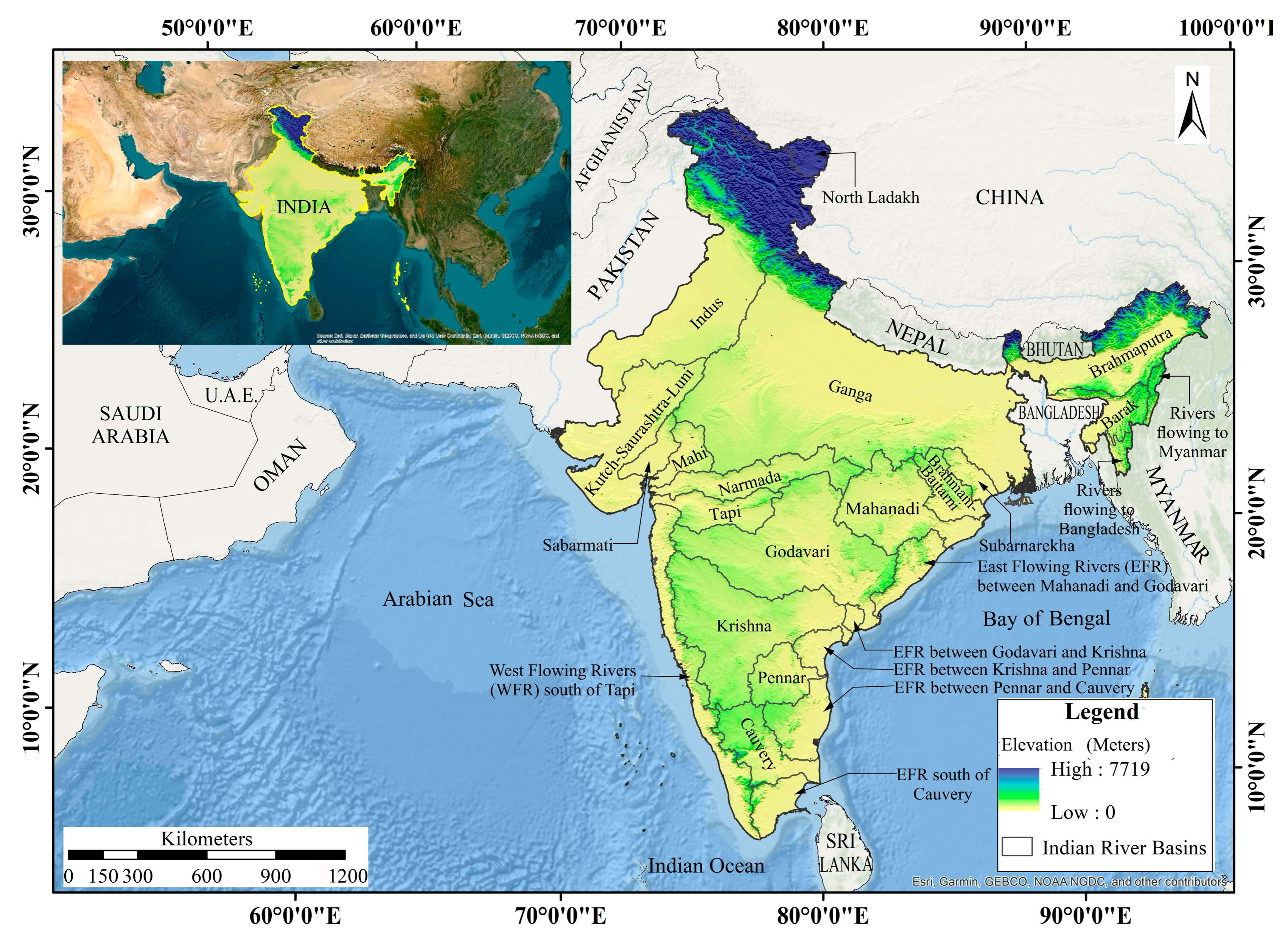
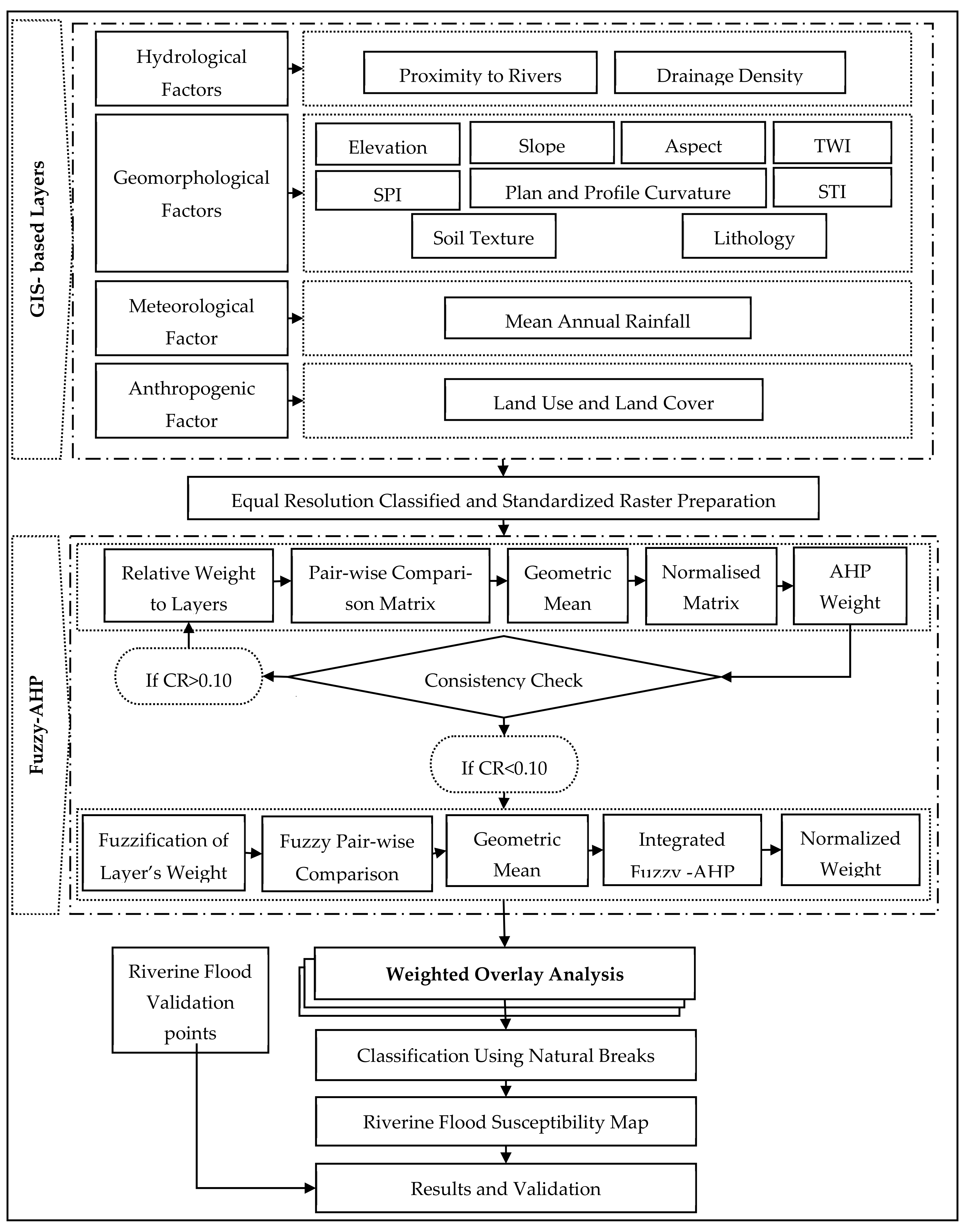
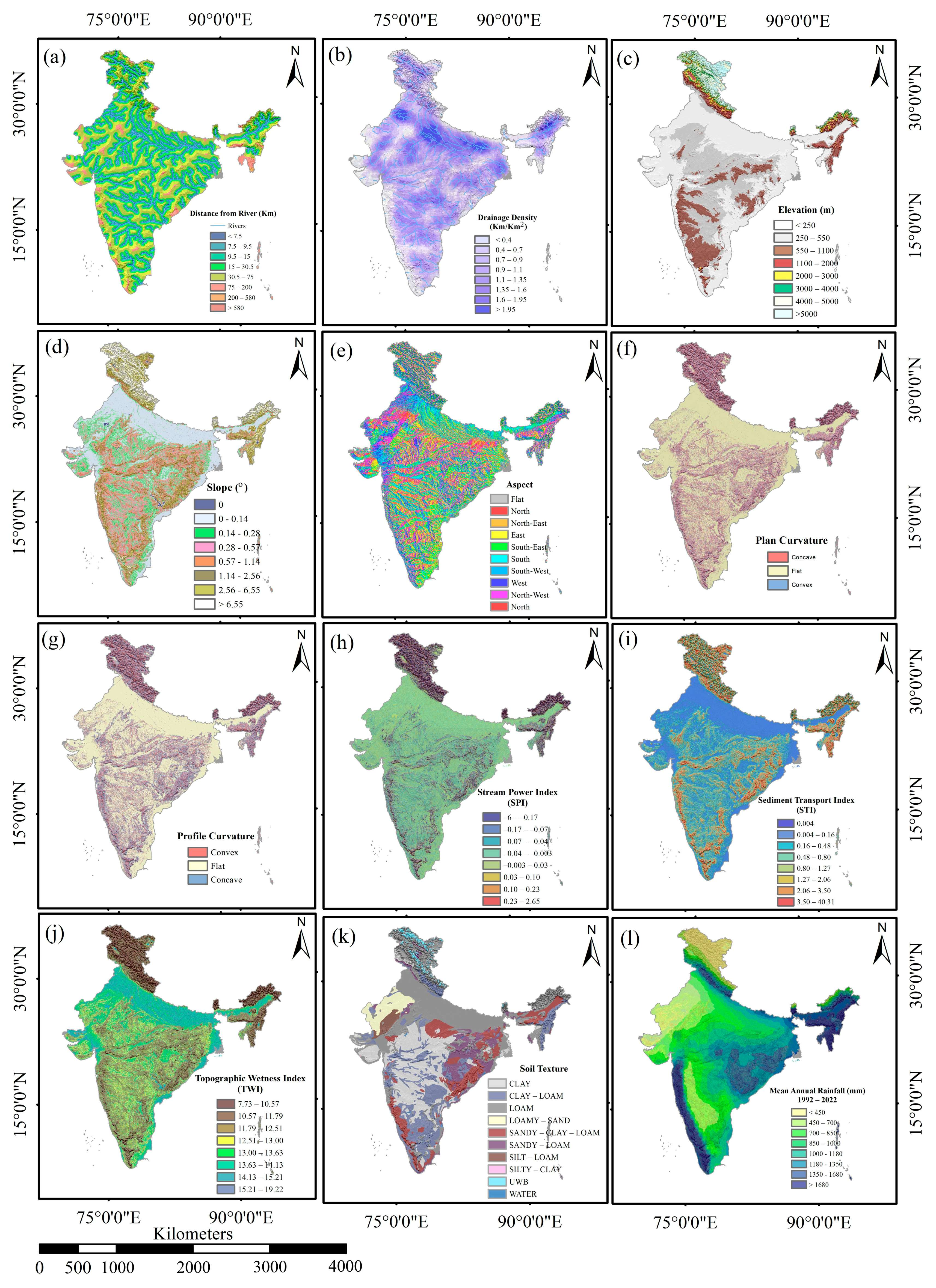
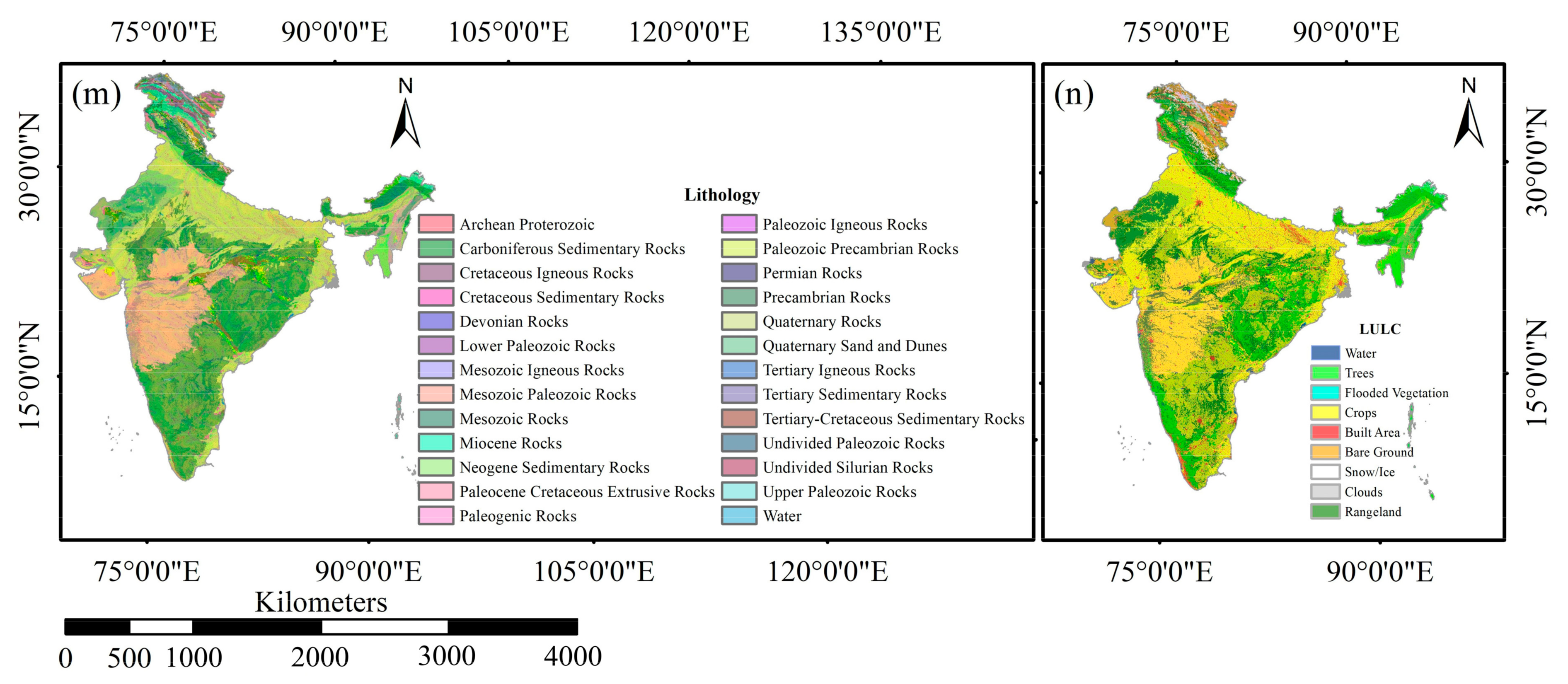
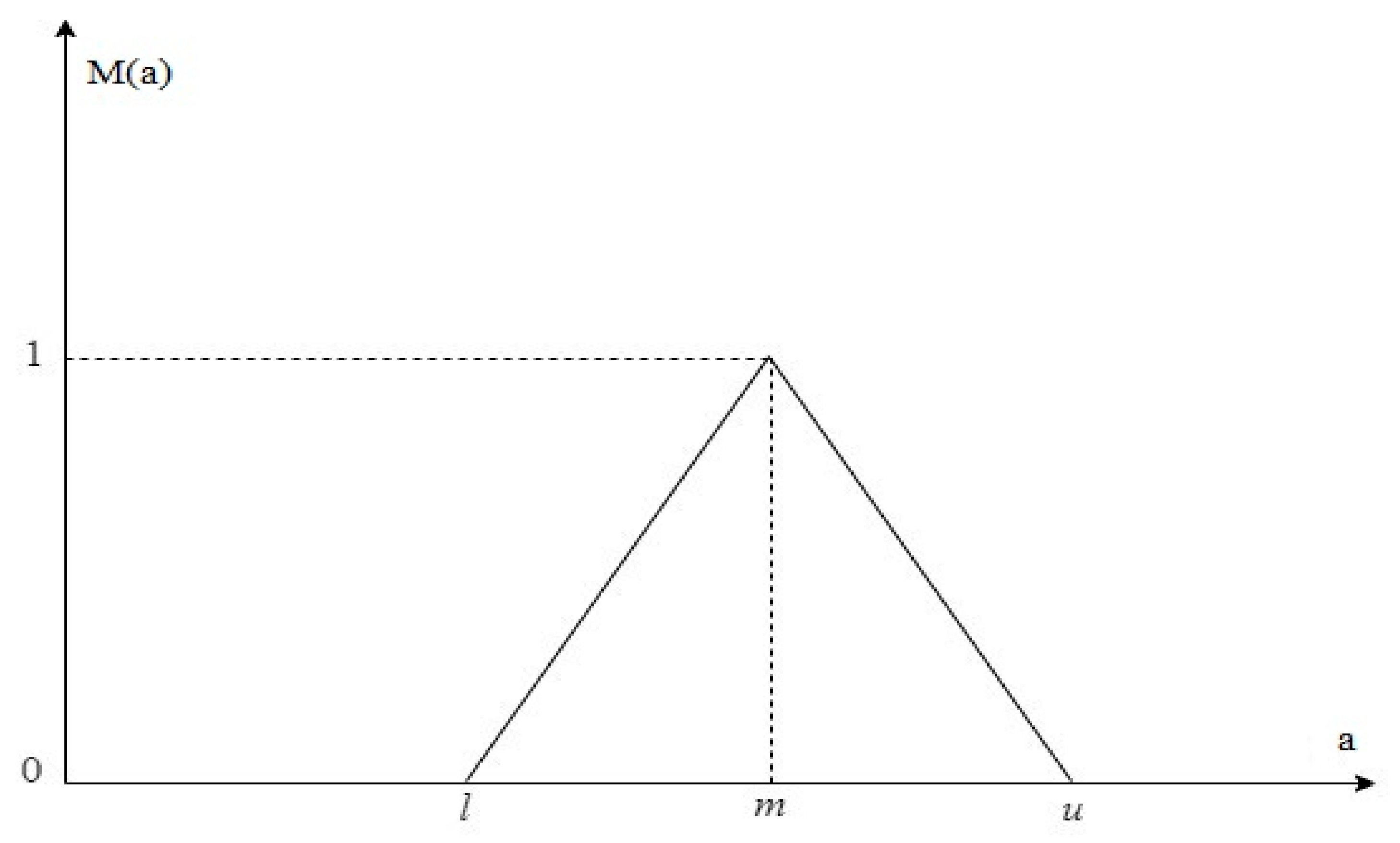
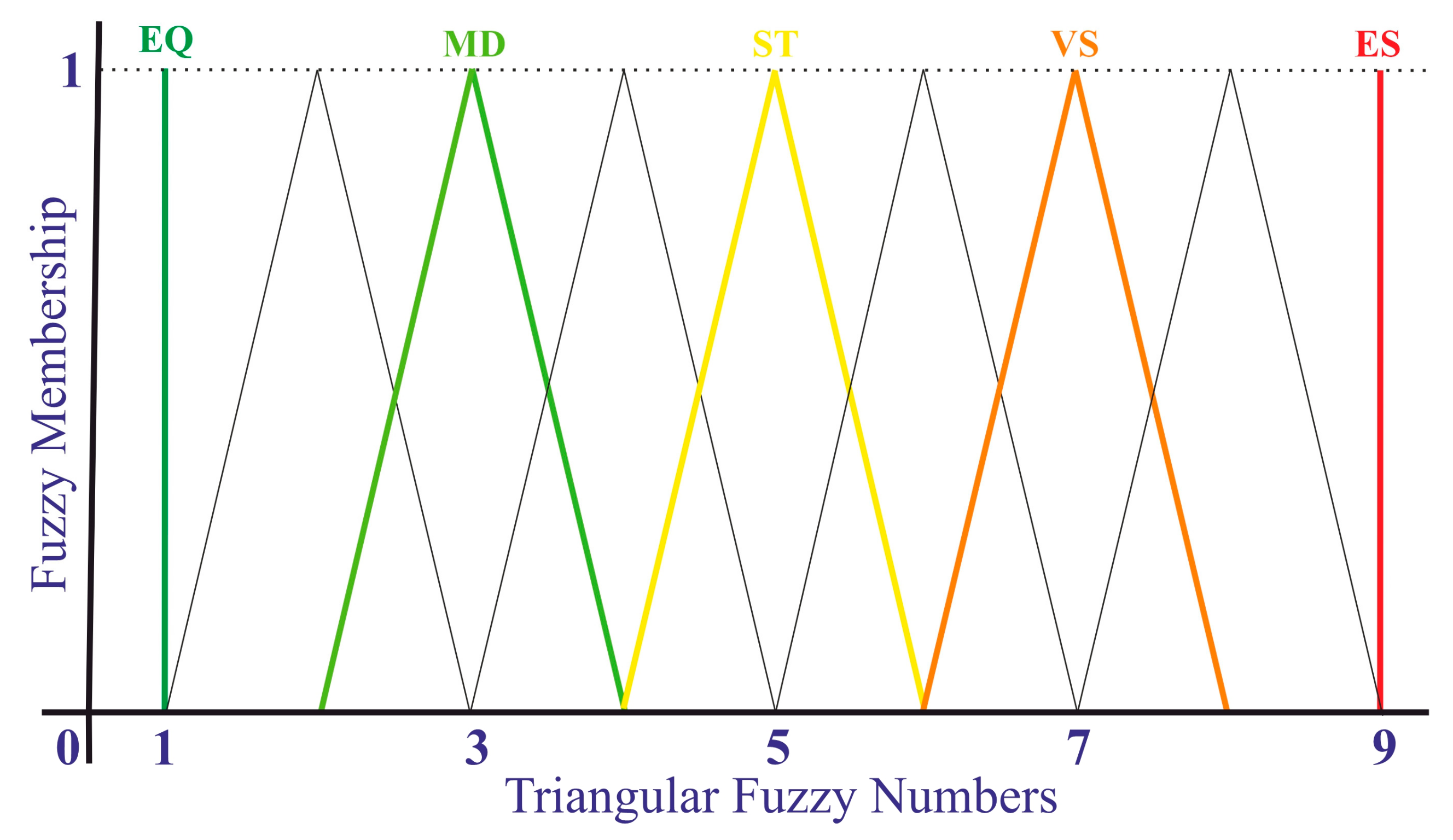
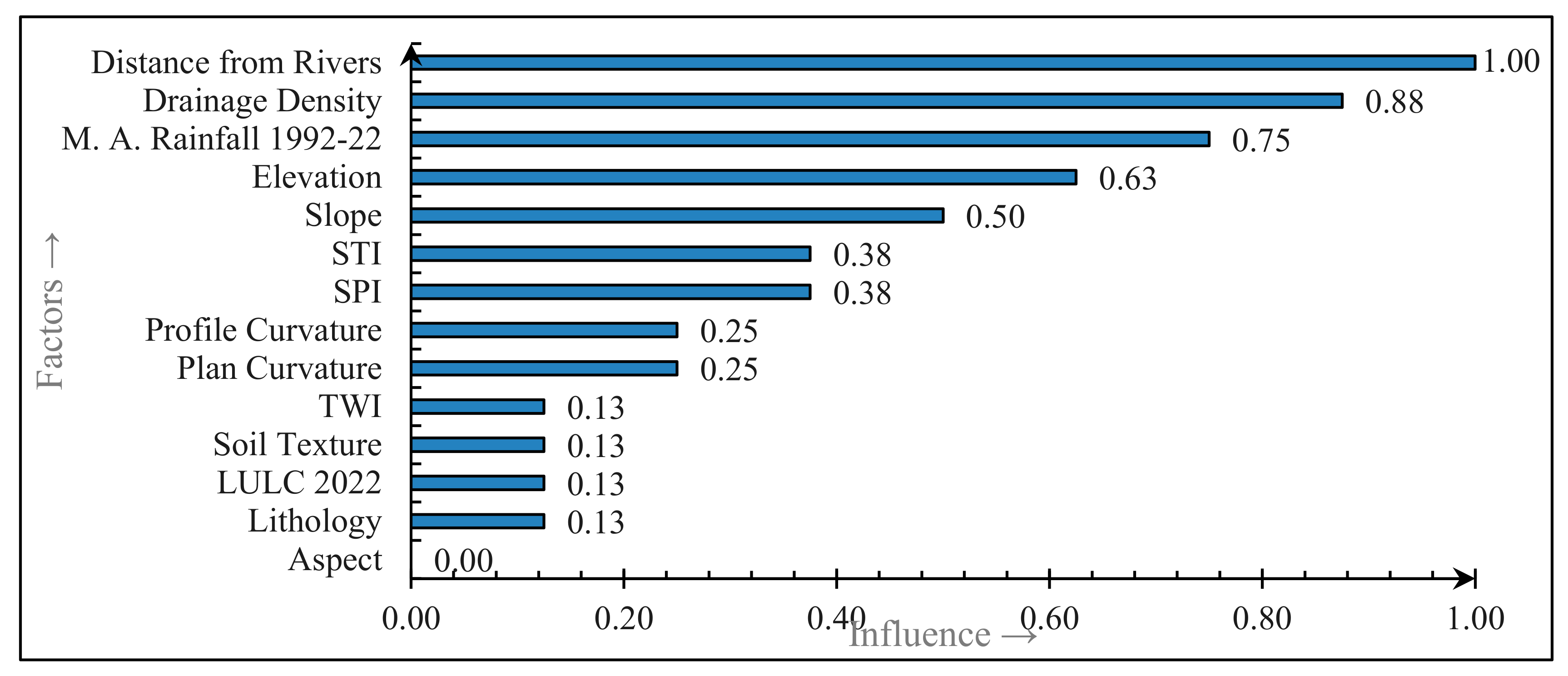
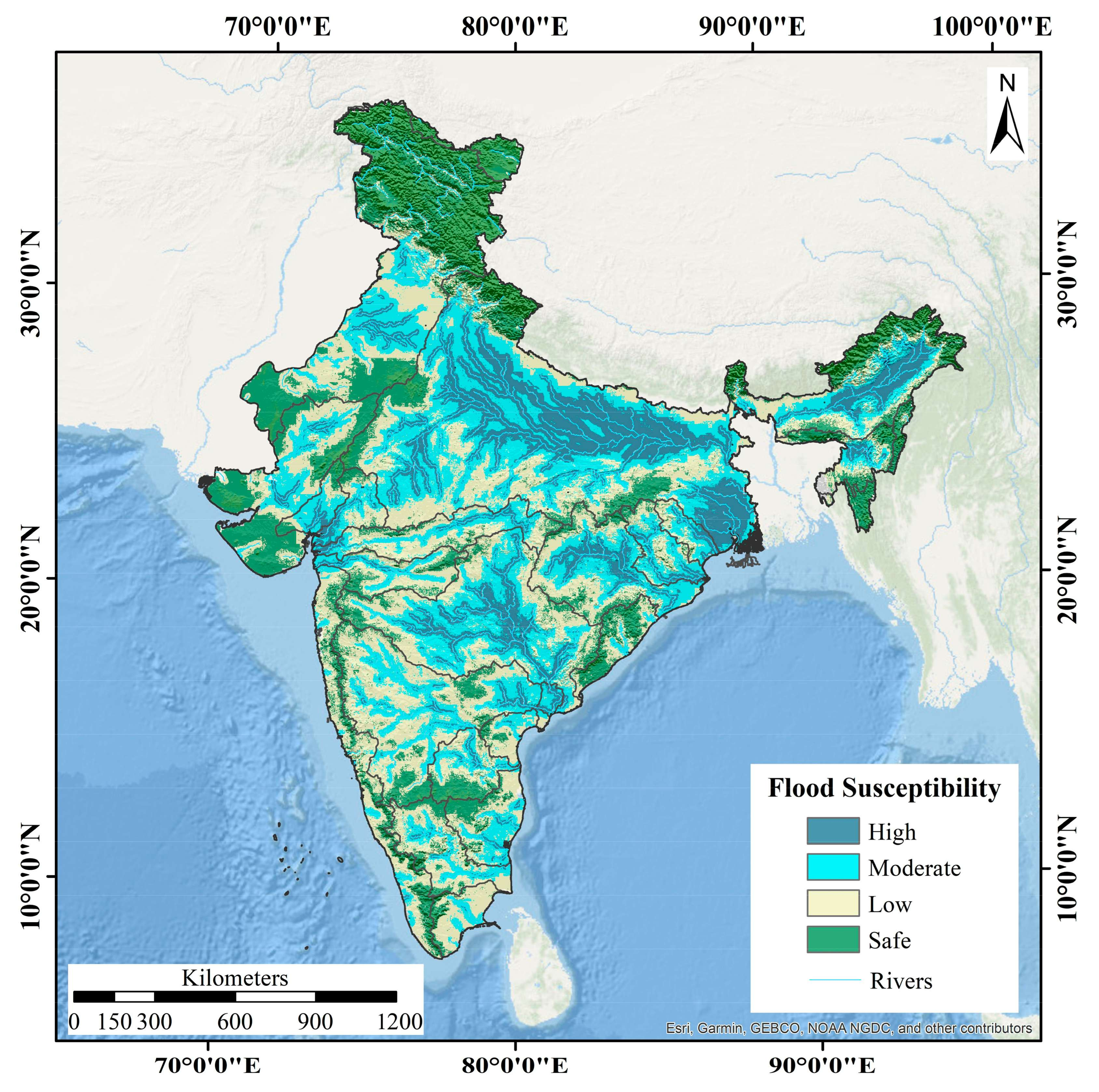
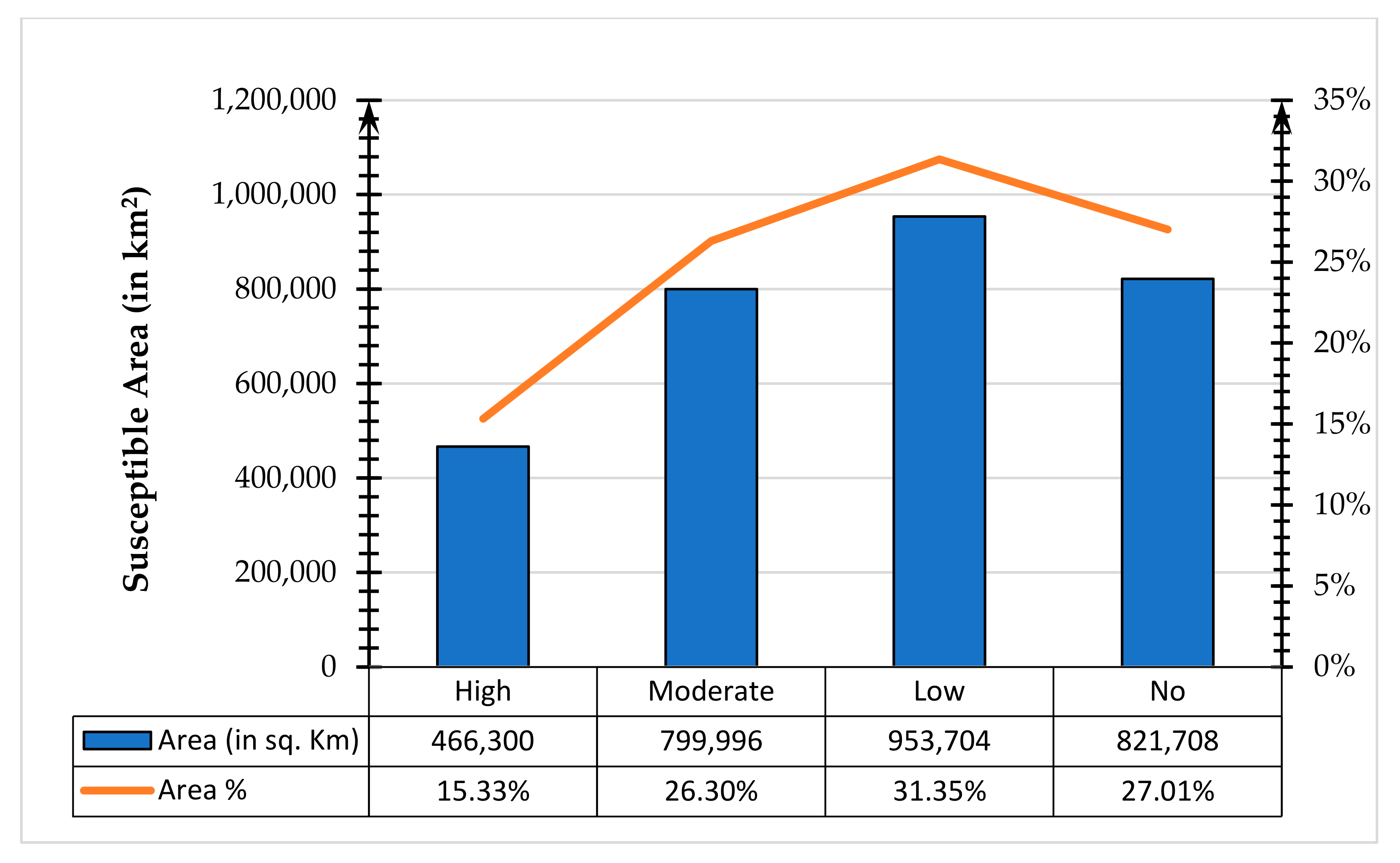
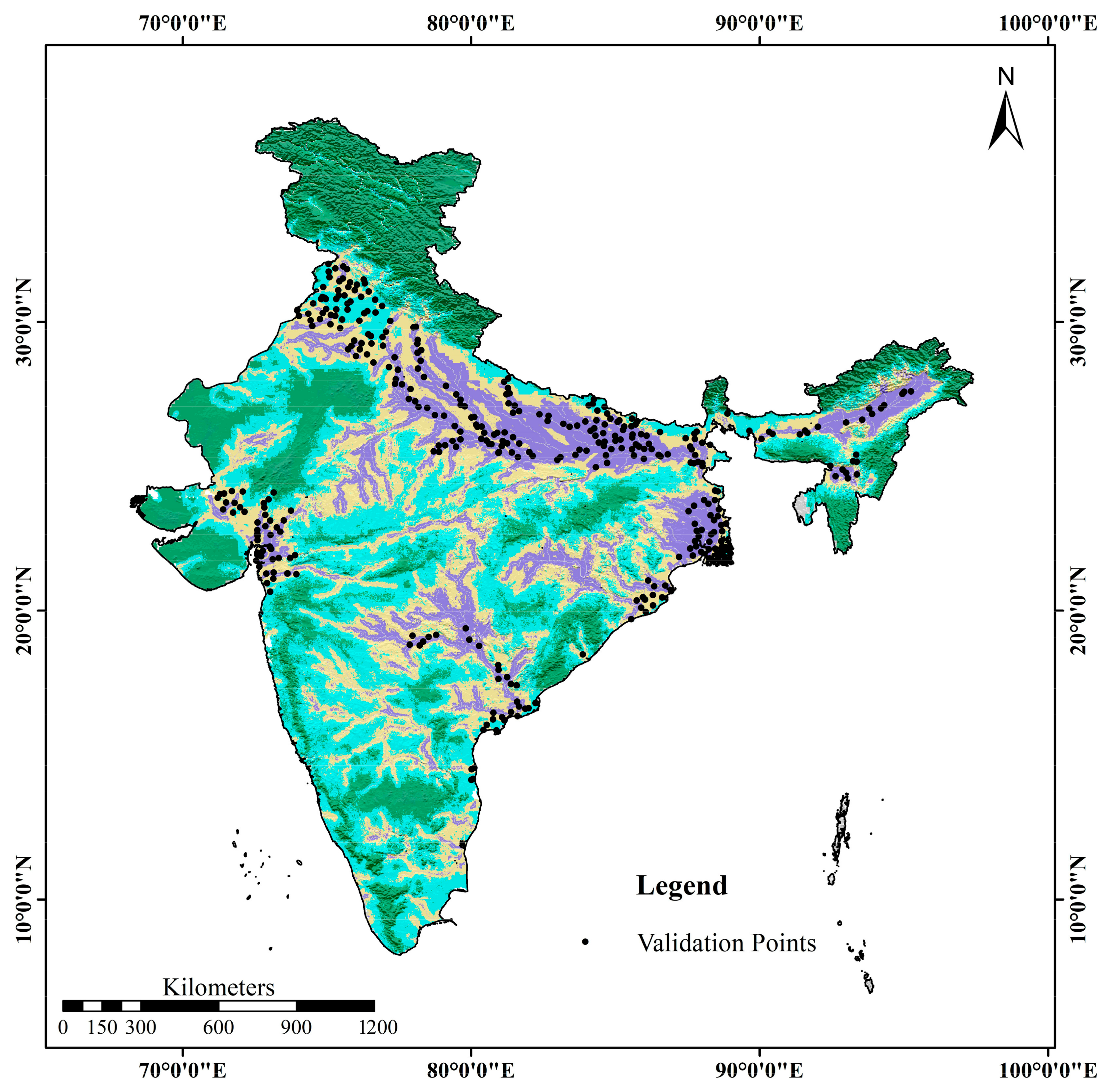
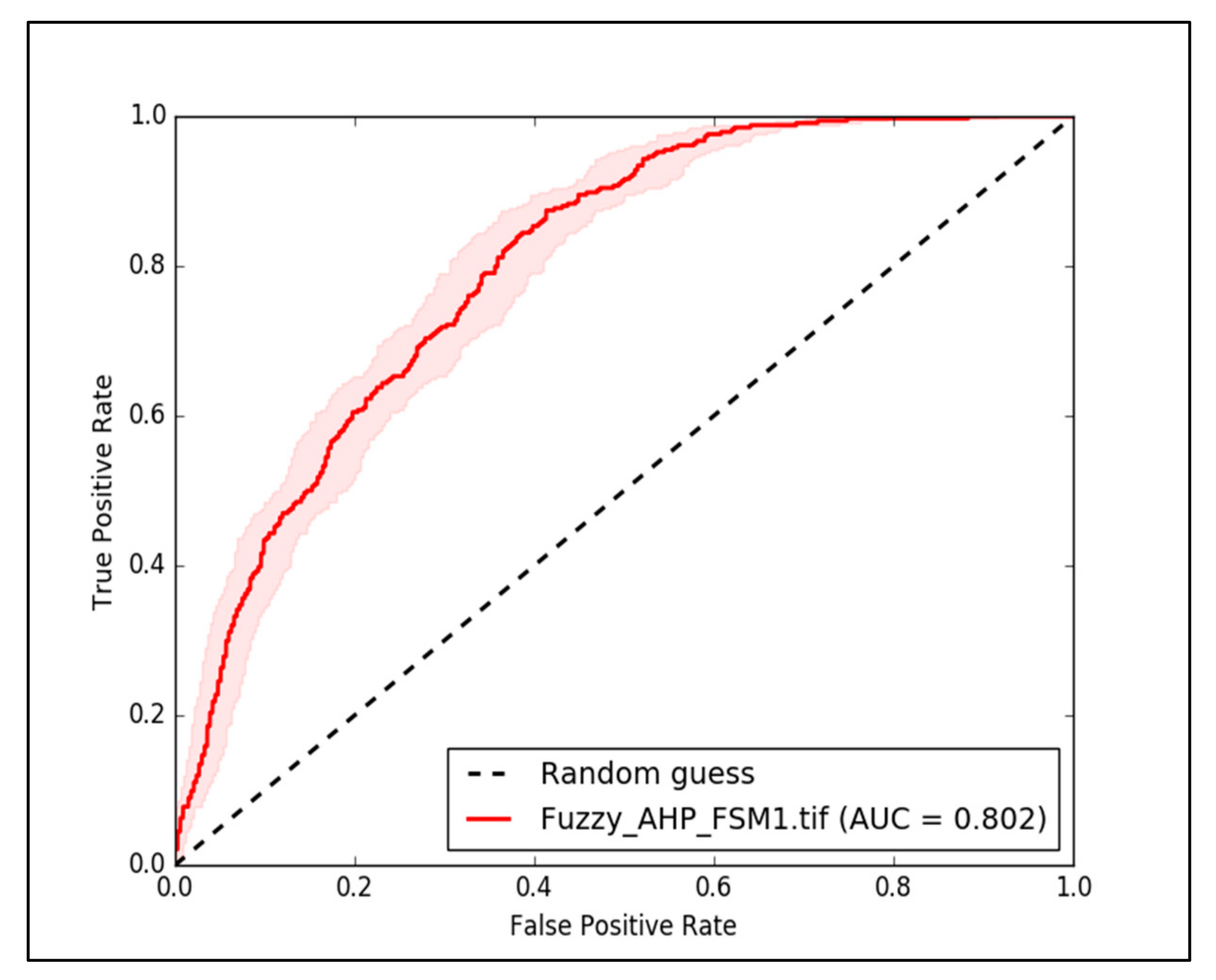
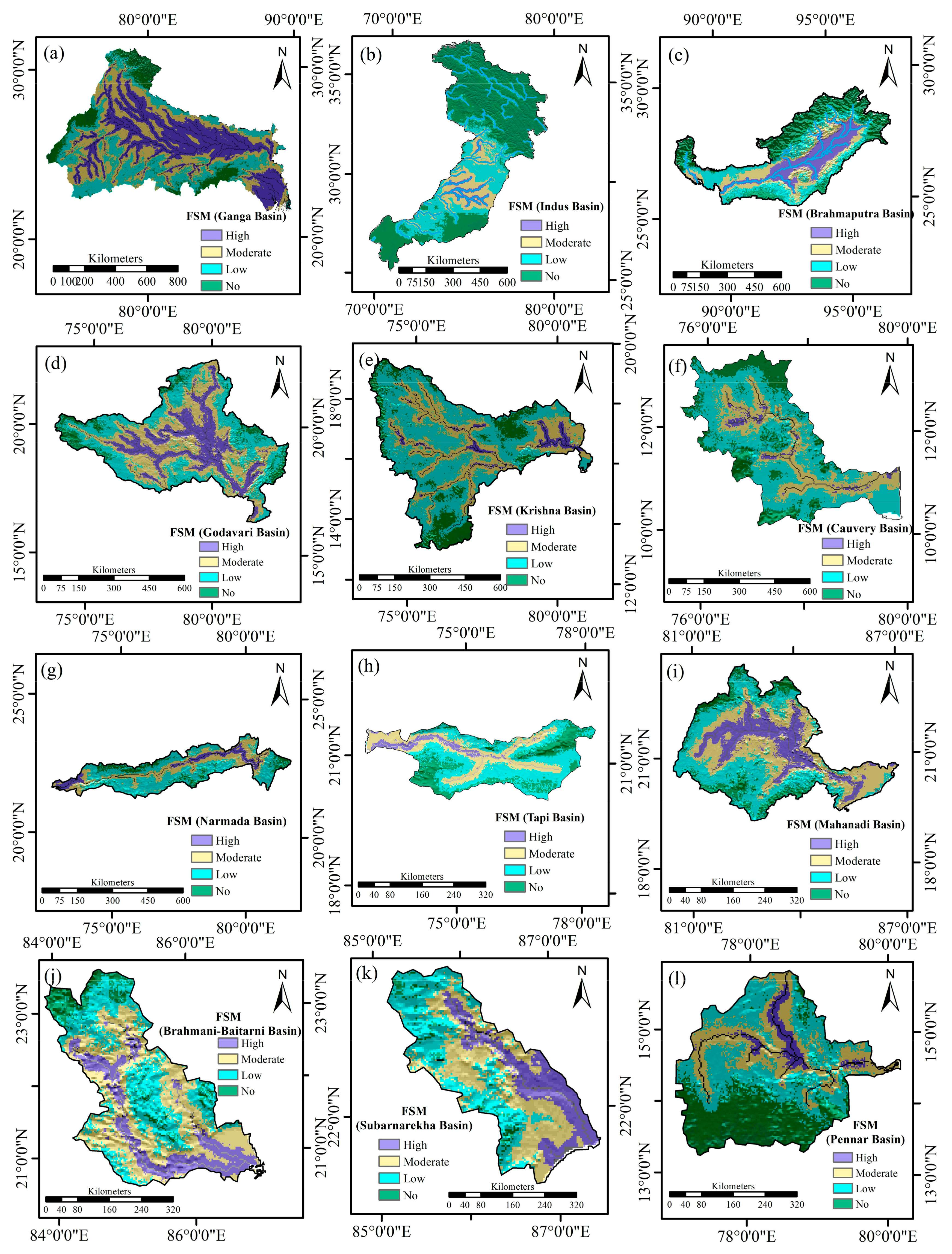
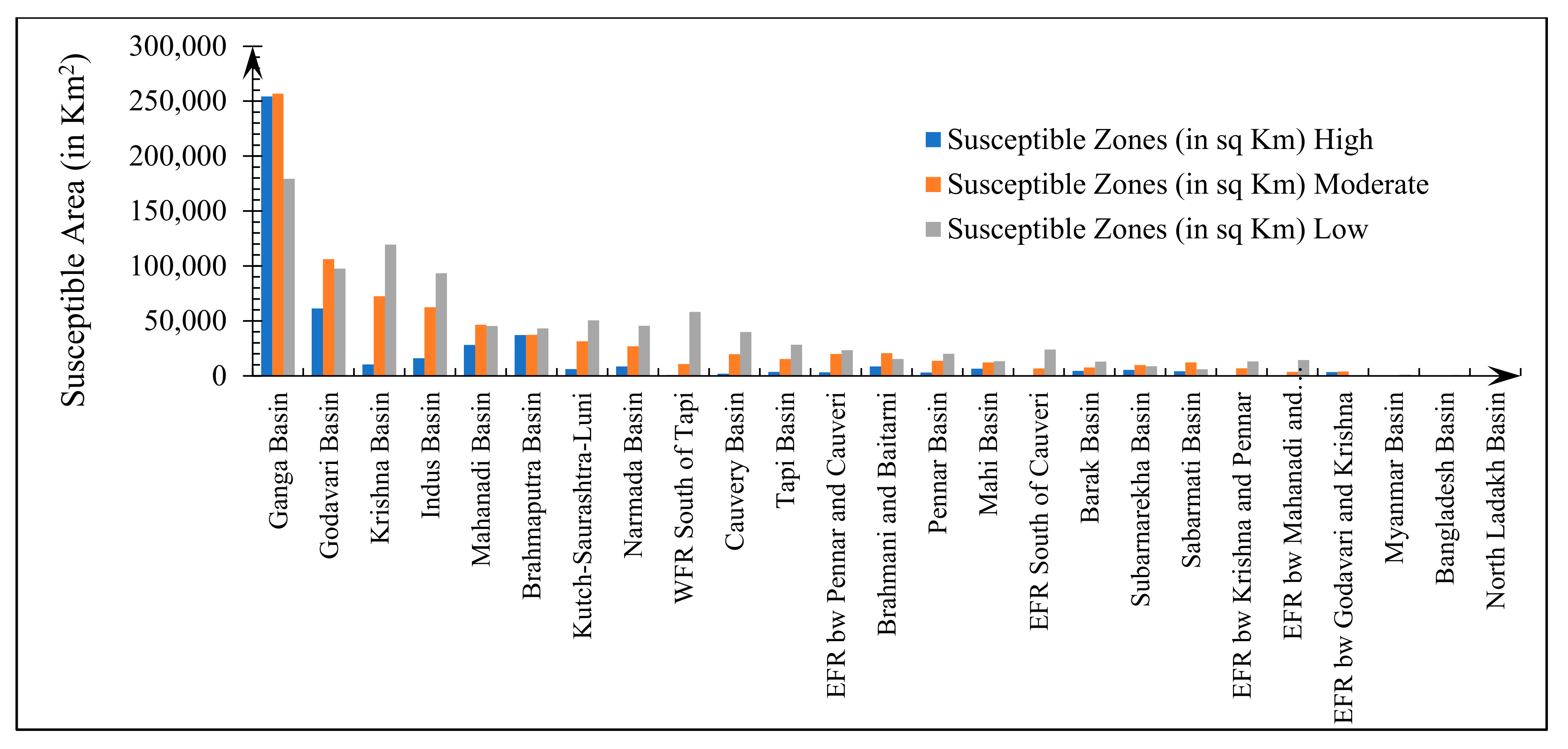
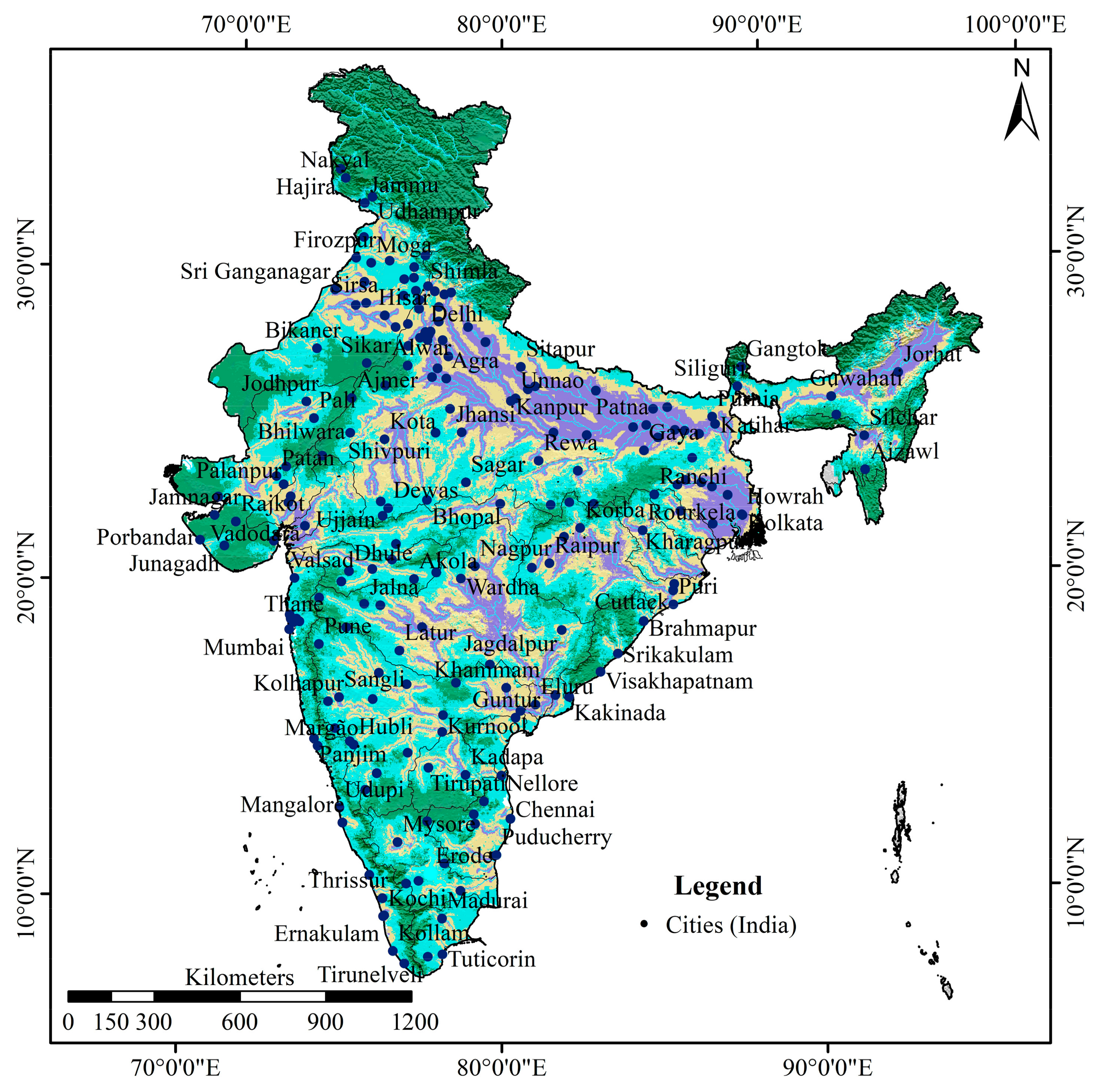

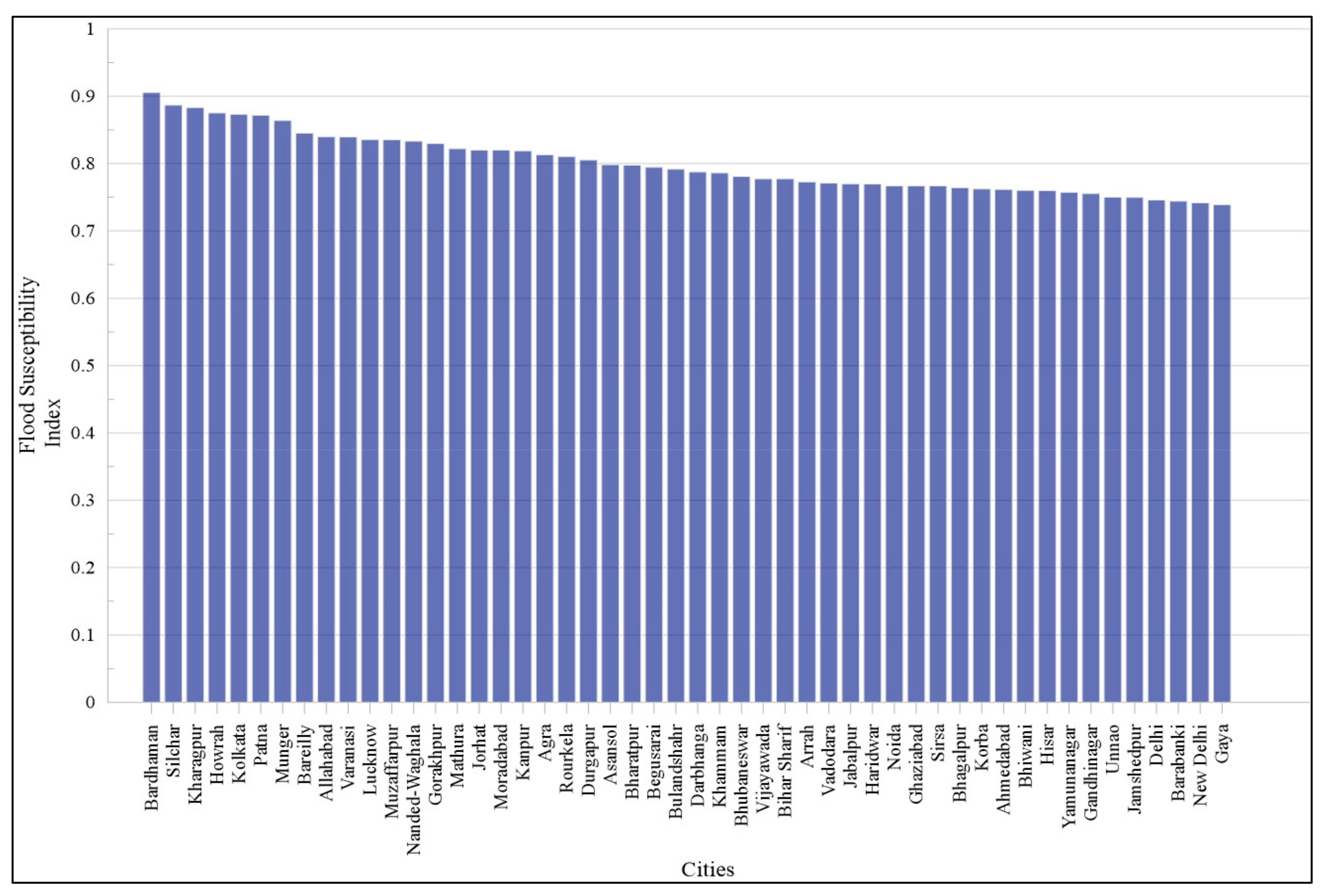
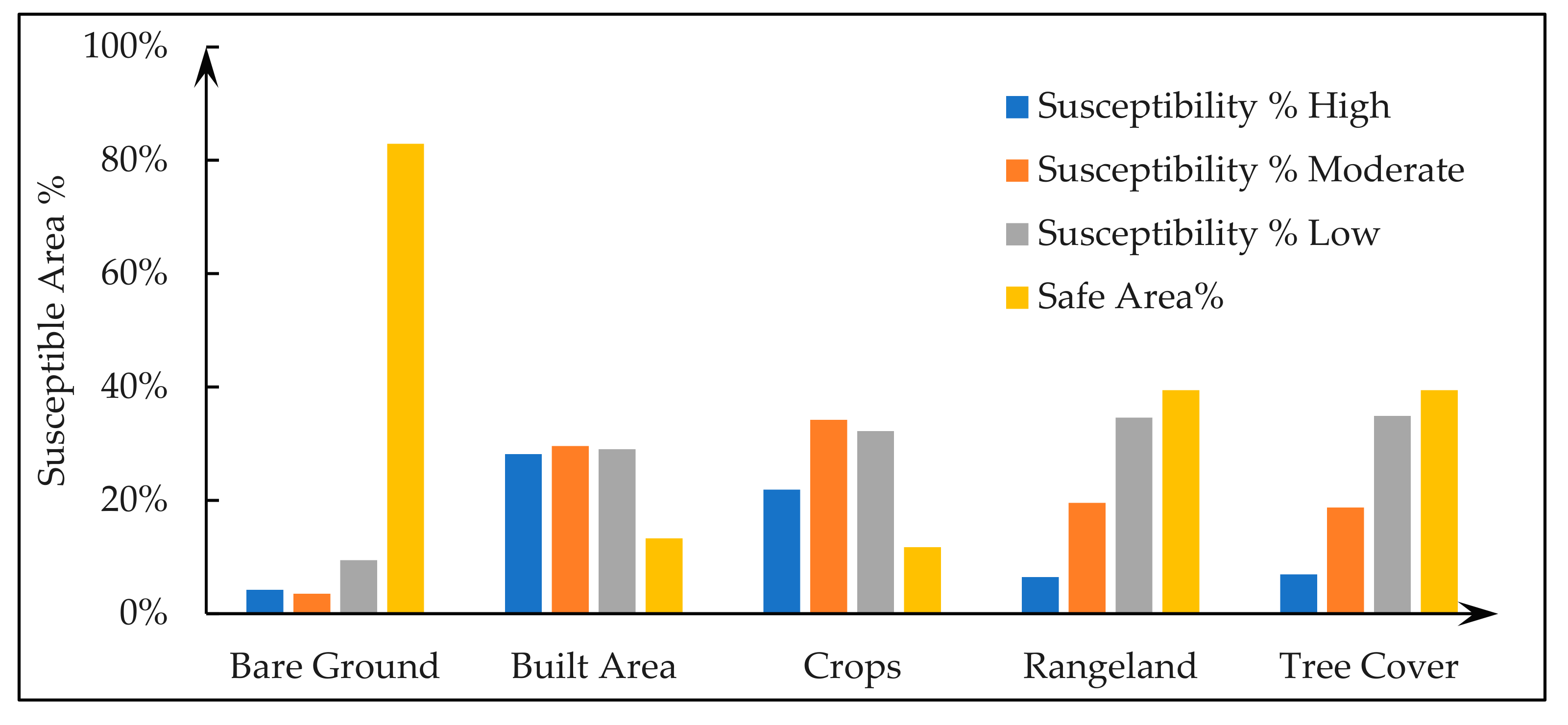
| Factors | Map Layer | Resolution/Scale | Preparation Method | Relation with Flood Susceptibility | Data Source | Period |
|---|---|---|---|---|---|---|
| Hydrological Factors | Proximity to Rivers | 30 m × 30 m | Multiple ring buffering | Positive Relation | SRTM Plus V3 (https://earthexplorer.usgs.gov/); accessed on 30 October 2022. | 2013 |
| Drainage Density | Spatial analysis using the line density tool | |||||
| Geomorphological Factors | Elevation | DEM Classification Spatial analysis using slope, aspect and curvature tools respectively | Negative Relation | |||
| Slope | ||||||
| Aspect | North Facing More Susceptible and vice-versa | |||||
| Plan Curvature | Negative Relation | |||||
| Profile Curvature | Positive Relation | |||||
| TWI | Calculating map algebra using raster calculator and Equations (1) and (2) | |||||
| SPI | ||||||
| STI | ||||||
| Soil Texture | 1:5,000,000 | Clipped from World Soil Database. Sequence No. matched in attribute table | Negative Relation | FAO (https://data.apps.fao.org/map/catalog/srv/eng/catalog.search#/metadata/cc45a270-88fd-11da-a88f-000d939bc5d8); accessed on 4 December 2022. | 1972 | |
| Lithology | Clipped from World Geology Database | USGS WEP (https://pubs.er.usgs.gov/publication/ofr97470C); accessed on 7 November 2022. | 1997 | |||
| Meteorological Factor | Mean Annual Rainfall | 0.5° × 0.5° | 30 years gridded data interpolation using IDW | Positive Relation | CRU TS v. 4.07 (https://crudata.uea.ac.uk/cru/data/hrg/cru_ts_4.07/cruts.2304141047.v4.07/pre/); accessed on 22 March 2023. | 1992–2022 |
| Anthropogenic Factor | LULC | 10 m × 10 m | Clipped from World LULC Database | SENTINEL 2A (https://www.arcgis.com/home/item.html?id=d3da5dd386d140cf93fc9ecbf8da5e31); accessed on 10 November 2022. | 2020 | |
| Ancillary Data | India Outline | 1:1,000,000 | Downloaded and merged internal polygons | SOI (https://onlinemaps.surveyofindia.gov.in/Digital_Product_Show.aspx); accessed on 30 October 2022. |
| Saaty Scale | Linguistic Terms | Triangular Fuzzy Numbers Scale | Reversed Values | TFN Conversion |
|---|---|---|---|---|
| 1 | Equal (EQ) | (1,1,1) | 1/1 | (1/1, 1/1, 1/1) |
| 3 | Moderate (MD) | (2,3,4) | 1/3 | (1/4, 1/3, 1/2) |
| 5 | Strong (ST) | (4,5,6) | 1/5 | (1/6, 1/5, 1/4) |
| 7 | Very Strong (VS) | (6,7,8) | 1/7 | (1/8, 1/7, 1/6) |
| 9 | Extremely Strong (ES) | (9,9,9) | 1/9 | (1/9, 1/9, 1/9) |
| 2 | (1,2,3) | 1/2 | (1/3, 1/2, 1/1) | |
| 4 | Intermediate Values | (3,4,5) | 1/4 | (1/5, 1/4, 1/3) |
| 6 | (5,6,7) | 1/6 | (1/7, 1/6, 1/5) | |
| 8 | (7,8,9) | 1/8 | (1/9, 1/8, 1/7) |
| n | 3 | 4 | 5 | 6 | 7 | 8 | 9 | 10 | 11 | 12 | 13 | 14 | 15 |
| RI | 0.58 | 0.90 | 1.12 | 1.24 | 1.32 | 1.41 | 1.45 | 1.51 | 1.52 | 1.54 | 1.56 | 1.58 | 1.59 |
| Factors | Rank | Influence |
|---|---|---|
| Distance from Rivers | 14 | 1.00 |
| Drainage Density | 13 | 0.88 |
| M. A. Rainfall 1992–2022 | 12 | 0.75 |
| Elevation | 11 | 0.63 |
| Slope | 10 | 0.50 |
| SPI | 9 | 0.38 |
| STI | 9 | 0.38 |
| Plan Curvature | 8 | 0.25 |
| Profile Curvature | 8 | 0.25 |
| Lithology | 7 | 0.13 |
| LULC 2022 | 7 | 0.13 |
| Soil Texture | 7 | 0.13 |
| TWI | 7 | 0.13 |
| Aspect | 6 | 0.00 |
| Factors | Geometric Mean | Fuzzy Weights | Normalized Weights | ||||
|---|---|---|---|---|---|---|---|
| Distance from Rivers | 4.08 | 4.93 | 5.74 | 0.2359 | 0.2284 | 0.2170 | 0.2271 |
| Drainage Density | 3.41 | 4.14 | 4.91 | 0.1975 | 0.1918 | 0.1855 | 0.1916 |
| Rainfall 1992–2022 | 2.81 | 3.41 | 4.10 | 0.1628 | 0.1580 | 0.1549 | 0.1586 |
| Elevation | 1.17 | 1.59 | 1.99 | 0.0677 | 0.0738 | 0.0753 | 0.0722 |
| Slope | 1.18 | 1.57 | 1.95 | 0.0682 | 0.0728 | 0.0739 | 0.0716 |
| SPI | 1.01 | 1.29 | 1.67 | 0.0583 | 0.0597 | 0.0631 | 0.0604 |
| STI | 1.01 | 1.29 | 1.67 | 0.0583 | 0.0597 | 0.0631 | 0.0604 |
| Plan Curvature | 0.53 | 0.73 | 0.99 | 0.0307 | 0.0339 | 0.0372 | 0.0339 |
| Profile Curvature | 0.52 | 0.72 | 0.97 | 0.0301 | 0.0333 | 0.0368 | 0.0334 |
| Lithology | 0.39 | 0.48 | 0.61 | 0.0227 | 0.0221 | 0.0231 | 0.0226 |
| LULC 2022 | 0.38 | 0.46 | 0.59 | 0.0218 | 0.0214 | 0.0225 | 0.0219 |
| Soil Texture | 0.38 | 0.46 | 0.59 | 0.0218 | 0.0214 | 0.0225 | 0.0219 |
| TWI | 0.23 | 0.29 | 0.38 | 0.0133 | 0.0134 | 0.0142 | 0.0136 |
| Aspect | 0.19 | 0.22 | 0.29 | 0.0108 | 0.0104 | 0.0108 | 0.0107 |
| BASINS | Susceptible Zones (in km2) | Susceptible Area (in km2) | Safe Area (in km2) | Total Area (in km2) | High Susceptible Area % | ||
|---|---|---|---|---|---|---|---|
| High | Moderate | Low | |||||
| Ganga Basin | 25,4296 | 256,740 | 179,304 | 690,340 | 86,968 | 777,308 | 32.71 |
| Godavari Basin | 61,368 | 106,192 | 97,676 | 265,236 | 26,808 | 292,044 | 21.01 |
| Krishna Basin | 10,316 | 72,428 | 119,496 | 202,240 | 41,728 | 243,968 | 4.23 |
| Indus Basin | 16,132 | 62,488 | 93,304 | 168,996 | 263,280 | 432,276 | 3.73 |
| Mahanadi Basin | 28,124 | 46,484 | 45,348 | 119,956 | 18,868 | 138,824 | 20.26 |
| Brahmaputra Basin | 37,184 | 37,344 | 43,112 | 117,640 | 57,740 | 175,380 | 21.20 |
| Kutch-Saurashtra-Luni Basin | 6100 | 31,472 | 50,424 | 87,996 | 86,352 | 174,348 | 3.50 |
| Narmada Basin | 8536 | 26,912 | 45,596 | 81,044 | 10,880 | 91,924 | 9.29 |
| WFR South of Tapi Basin | 656 | 10,800 | 58,252 | 69,708 | 42,432 | 112,140 | 0.58 |
| Cauvery Basin | 1980 | 19,676 | 39,796 | 61,452 | 16,776 | 78,228 | 2.53 |
| Tapi Basin | 3512 | 15,340 | 28,252 | 47,104 | 15,496 | 62,600 | 5.61 |
| EFR bw Pennar and Cauvery Basin | 3228 | 19,900 | 23,424 | 46,552 | 16,500 | 63,052 | 5.12 |
| Brahmani and Baitarni Basin | 8572 | 20,572 | 15,244 | 44,388 | 4416 | 48,804 | 17.56 |
| Pennar Basin | 2968 | 13,720 | 20,124 | 36,812 | 17,760 | 54,572 | 5.44 |
| Mahi Basin | 6500 | 12,128 | 13,232 | 31,860 | 5060 | 36,920 | 17.61 |
| EFR South of Cauvery Basin | 112 | 6712 | 23,876 | 30,700 | 7148 | 37,848 | 0.30 |
| Barak Basin | 4556 | 7552 | 13,008 | 25,116 | 19,596 | 44,712 | 10.19 |
| Subarnarekha Basin | 5504 | 9920 | 8724 | 24,148 | 900 | 25,048 | 21.97 |
| Sabarmati Basin | 4180 | 12,252 | 6000 | 22,432 | 7092 | 29,524 | 14.16 |
| EFR bw Krishna and Pennar Basin | 348 | 6928 | 13,044 | 20,320 | 4212 | 24,532 | 1.42 |
| EFR bw Mahanadi and Godavari Basins | 20 | 3632 | 14,400 | 18,052 | 25,340 | 43,392 | 0.05 |
| EFR bw Godavari and Krishna Basin | 3436 | 4044 | 128 | 7608 | 0 | 7608 | 45.16 |
| Myanmar Basin | 0 | 12 | 988 | 1000 | 8148 | 9148 | 0.00 |
| Bangladesh Basin | 0 | 0 | 652 | 652 | 10,476 | 11,128 | 0.00 |
| North Ladakh Basin | 0 | 0 | 296 | 296 | 26,080 | 26,376 | 0.00 |
| Land Cover | Susceptible Zones (in km2) | Susceptible Area (in km2) | Safe Area (in km2) | Total Area (in km2) | ||
|---|---|---|---|---|---|---|
| High | Moderate | Low | ||||
| Bare Ground | 5916 | 4936 | 13,304 | 130,412 | 117,108 | 141,264 |
| Built Area | 37,896 | 39,868 | 39,080 | 56,964 | 17,884 | 134,728 |
| Crops | 334,492 | 522,928 | 492,880 | 672,000 | 179,120 | 1,529,420 |
| Rangeland | 42,304 | 128,552 | 227,416 | 486,512 | 259,096 | 657,368 |
| Tree Cover | 34,424 | 93,232 | 173,556 | 369,840 | 196,284 | 497,496 |
Disclaimer/Publisher’s Note: The statements, opinions and data contained in all publications are solely those of the individual author(s) and contributor(s) and not of MDPI and/or the editor(s). MDPI and/or the editor(s) disclaim responsibility for any injury to people or property resulting from any ideas, methods, instructions or products referred to in the content. |
© 2023 by the authors. Licensee MDPI, Basel, Switzerland. This article is an open access article distributed under the terms and conditions of the Creative Commons Attribution (CC BY) license (https://creativecommons.org/licenses/by/4.0/).
Share and Cite
Kumar, R.; Kumar, M.; Tiwari, A.; Majid, S.I.; Bhadwal, S.; Sahu, N.; Avtar, R. Assessment and Mapping of Riverine Flood Susceptibility (RFS) in India through Coupled Multicriteria Decision Making Models and Geospatial Techniques. Water 2023, 15, 3918. https://doi.org/10.3390/w15223918
Kumar R, Kumar M, Tiwari A, Majid SI, Bhadwal S, Sahu N, Avtar R. Assessment and Mapping of Riverine Flood Susceptibility (RFS) in India through Coupled Multicriteria Decision Making Models and Geospatial Techniques. Water. 2023; 15(22):3918. https://doi.org/10.3390/w15223918
Chicago/Turabian StyleKumar, Ravi, Manish Kumar, Akash Tiwari, Syed Irtiza Majid, Sourav Bhadwal, Netrananda Sahu, and Ram Avtar. 2023. "Assessment and Mapping of Riverine Flood Susceptibility (RFS) in India through Coupled Multicriteria Decision Making Models and Geospatial Techniques" Water 15, no. 22: 3918. https://doi.org/10.3390/w15223918
APA StyleKumar, R., Kumar, M., Tiwari, A., Majid, S. I., Bhadwal, S., Sahu, N., & Avtar, R. (2023). Assessment and Mapping of Riverine Flood Susceptibility (RFS) in India through Coupled Multicriteria Decision Making Models and Geospatial Techniques. Water, 15(22), 3918. https://doi.org/10.3390/w15223918











